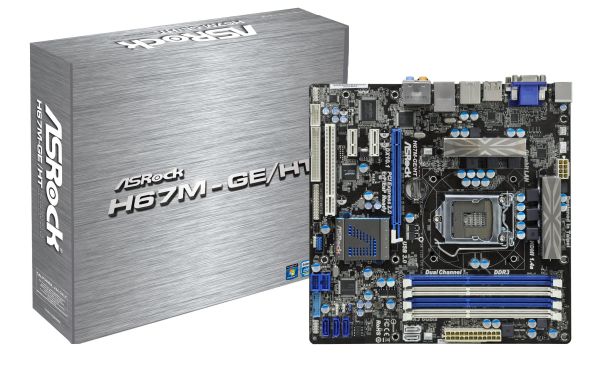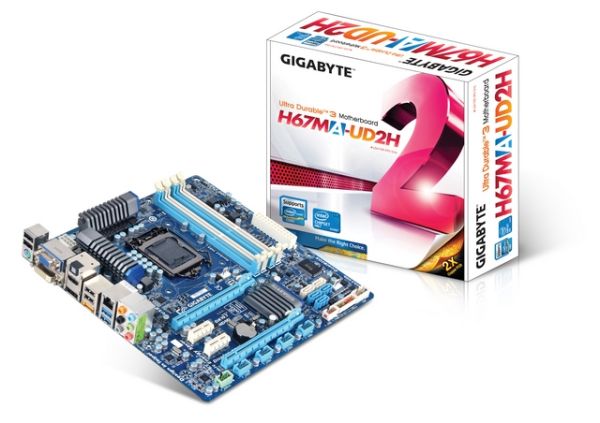H67 – A Triumvirate of Tantalizing Technology
by Ian Cutress on March 27, 2011 6:25 PM EST- Posted in
- Motherboards
- Sandy Bridge
- H67
Overview
With Intel’s recall at the beginning of the year, just after release, vendors are now starting to make versions of their fixed chipsets available to end users. As I mentioned at the very beginning of this review, what we are technically looking at are the B2 samples, as these were distributed to us before the recall. Every manufacturer here has confirmed that the B3 versions of these boards perform exactly the same as the B2, but will either be released with the same name but a B3 sticker on the box, or the name will be adapted with the B3 edition – so the Gigabyte H67MA-UD2H becomes the Gigabyte H67MA-UD2H-B3.
With H67, we lose the CPU overclocking of the P67 and all the dual GPU lanes, and instead get access to the integrated GPU on the processor. As a result, manufacturers do not have to provide the H67 with oodles of high-quality VRMs to hold high CPU overclocks amongst other things, which bring the costs down. As such, our boards here are $120 (ASRock), $140 (ECS) and $125 (Gigabyte).
ASRock H67M-GE/HT
The ASRock H67M-GE/HT is relatively easy to use and performs well in our benchmark suite. At $120, with the additions in the package in the board, makes this a relatively comfortable H67 product. It does not have the features of some of the more expensive boards, such as a Debug LED and Power/Reset buttons, but once the board is installed in a case, it is quite rare that you will need these again. The board has legacy floppy connectors and a PS/2 keyboard port, which may be a selling point for some buyers still running legacy equipment. The H67M-GE/HT also runs cooler than other Sandy Bridge boards I have tested. The ASRock board comes with a one year warranty, with an option to extend for another year.
ECS H67H2-M
The ECS H67H2-M has a few serious check points against it as a board to use. The RAM timings in the BIOS are not changeable; the BIOS can be hard to navigate and does not implement any of the newer UEFI principles coming through with Sandy Bridge; the USB performance is sub-par, and the DPC Latency is the highest of the H67 boards we have tested. There are some very positive points with it – eJiffy is a great piece of software, you have double gigabit Ethernet ports, Power/Reset buttons on the board and a Debug LED, the 2D performance is better than average, and your fan options are better than some other vendors. I would prefer to see a cleaner BIOS, more fan headers and better USB performance become as standard. The ECS board comes with a three year warranty.
Gigabyte H67MA-UD2H
The Gigabyte H67MA-UD2H does not have a lot of physical features, unless you have need of lots of external USB ports. While it offers some BCLK overclocking, there are not enough fan headers on the board to support basic all-in-one water cooling, or more than one case fan. The SATA ports are oddly further into the board which is not ideal. The BIOS is however rock solid and simple to use, which is no small feat. The PCIe slots are not ideally laid out (I would prefer x1, x16, x1, x4), and in their current configuration would restrict RAM coolers when using a dual slot, long GPU. There are no Power/Reset buttons, no Debug LED, but the software included works and does its job. For $125, the ASRock beats it in bang for buck, but people will not be disappointed if they picked up the H67MA-UD2H (or rather, its B3 equivalent, the H67MA-UD2H-B3). The Gigabyte board comes with a three year warranty.
Conclusion
There are a lot of options in the world of H67 but there are also a lot of pitfalls. For a board to have all the bells and whistles (presumably, some imaginary board with all the best bits from every other board), you would easily be pushing into P67 price territory and then some more. There is not much between all the boards in terms of performance, so you may end up looking at what is included with the board or features for a final decision.
The biggest surprise for me however is the loss of a multiplier on single-threaded loads on H67. On all three boards, the BIOS/UEFI had 37x multiplier set for single thread loads, but in the OS, it would only ever go to 36x. We're told that this is part of the Intel chipset specifications for H67, but this ultimately means that the consumer is losing that multiplier. Only with the Gigabyte board (out of these three) can you overcome this with BCLK overclocking, but ultimately that overclocking can be quite variable chip-to-chip.



01_575px.png)









56 Comments
View All Comments
bigboxes - Monday, March 28, 2011 - link
That's why I always have a spare video card for just such an emergency. Since my motherboards tend to be on the higher end they don't have video out anyways. I wouldn't want the mfg to take away other ports just to include video out. It makes sense on HTPC applications as well as low end or micro-ATX boxes where utility is the priority. I just buy a cheap card that is $30 after rebate and leave it in the box until I need it for troubleshooting or in case of emergency.rustycurse - Monday, March 28, 2011 - link
on page 1:"The same question ultimately applies to the Sandy Bridge chipsets – why only allow CPU overclocking on P67 (and Z68 in the future)? "
I was always thought that term 'Sandy Bridge' is applied to CPU technology and 'Cougar point' to the chipset or am I wrong?
...but about shown mobos ... neither of them suit my tasks. I won't buy it
crispbp04 - Monday, March 28, 2011 - link
"The ECS H67H2-M is a few serious check points against it as a board to use."is or has?
WasabiVengeance - Monday, March 28, 2011 - link
Quick question: How many of those vid outputs can the board actually use simultaneously? Previously intel chipsets were limited to 2.Shadowmaster625 - Monday, March 28, 2011 - link
"However, I remember the time when I was a scrimping student. I wanted high gaming performance at the lowest cost – if Sandy Bridge was out then, and I was specifically after the Sandy Bridge platform over anything AMD, then a H67 with an i3-2100 and the biggest graphics card I could afford would be a viable option."That would be a huge waste of money. Why buy an i3-2100 if you're just going to plug in a gpu anyway? And why buy an H67 when it clearly costs $50 beyond what it should, especially since it has no northbridge.
An ASRock M3A770DE motherboard AND an Athlon X3 cpu together costs the same as one of these H67 scams. Not to mention the $125 for the intel cpu. No way. If I needed more cpu performance I would get the Phenom II X4 965 Black Edition and still have an extra $50 that could go into a better gpu.
DaveSimmons - Monday, March 28, 2011 - link
For budget gaming, H61 seems the better choice by far, with motherboards in the $60-65 range, At that price the price advantage of AMD budget CPUs go away (at stock speed anyway) and the intel HSF is quieter than stock AMD HSF from what I've read.SilentPCReview compared Intel Core i3-2100 vs. AMD Phenom II X2 565 and the intel won on both performance and power use. Spend a bit more for an i5 and you'll have a solid midrange gaming system.at a budget price.
ritchan - Tuesday, March 29, 2011 - link
"With H67 and its no overclocking rule, the market that wants a cheaper board can get that cheaper board."Yet these reviewed boards are still on average more expensive than an AMD board in an equivalent market segment. Which support overclocking and core unlocking. Also, bargain bin motherboards haven't been known for their overclocking prowess, i.e. the power window argument doesn't hold. If you're buying cheap, you get that power window anyway.
Also notice how the cheaper AMD boards like the 870-UD3R or MSI's boards come with absolutely no heatsinks on the VRMs. Bye bye, power window argument.
Stop trying to justify negative market segmentation. The H67/P67 split is a step back from where things were before, and it only gives Intel a good excuse to charge extra for overclocking enabled chipsets in the future. Wait, they're already doing that... and you're sugarcoating it for them.
glad2meetu - Tuesday, March 29, 2011 - link
I think Intel has done a very poor job with the Sandy Bridge release. Intel appears like it is lost in the woods these days and needs a new CEO.I think I would choose a ASUS or a Gigabyte motherboard if I had to pick one for Sandy Bridge. I am surprised how poor the Intel chipsets are. Intel inside no longer means anything special.
strikeback03 - Tuesday, March 29, 2011 - link
The CPUs are special. The rest of the platform, not so much. If Z68 had been included at launch, and all 6 series chipsets had included USB3 and all SATA ports 6Gbps (not just 2) then I would have a different opinion.strikeback03 - Tuesday, March 29, 2011 - link
Is a cooling fan for RAM really necessary on a platform that allows essentially no overclocking and has relatively fixed memory settings?Also, Intel advertising these CPUs as having a certain multiplier in single-threaded mode then not letting the motherboards use that multiplier is a load of bull.